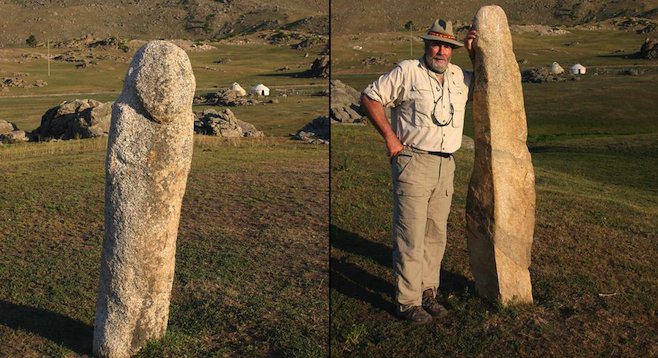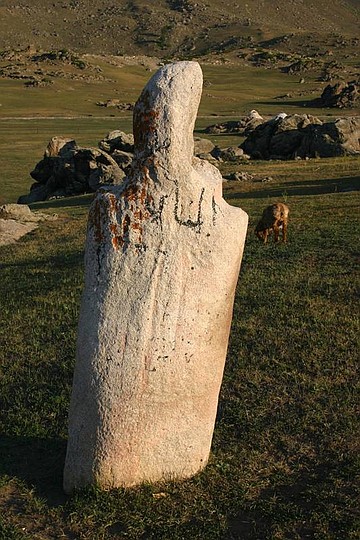 Facebook
Facebook
 X
X
 Instagram
Instagram
 TikTok
TikTok
 Youtube
Youtube

In the northwestern corner of China, where a pointed finger of land pokes into Russia and separates Kazakhstan from Mongolia, the last physical remains of the army of Genghis Khan stand watch.
The area is called Kanas, and it holds a gorgeous national park full of flowing emerald rivers and snow-capped peaks. While part of China, its inhabitants are Mongolian nomads – Tuvans, to be exact, unfortunately assigned a nationality by an arbitrary line on a map. For centuries they have roamed free over this land with no concession to borders.
Tuvans
The Tuvans claim descent from Khan's Mongol army that massed in this area before heading west to invade the so-called civilized world, and consider themselves the keepers of the ancient stone monoliths that remind the world of a nomadic cavalry that almost conquered the world's most modern, sophisticated armies of the day.
Like their ancestors, the Tuvans learn to ride as soon as they can walk. They live in felt yurts unchanged since the time of the great Khan, which dot these rolling valleys like blooming mushrooms. They are primarily animists with a smattering of Buddhism thrown in; shamanism dominates their spiritual and cultural life. Every home has a shrine to Genghis Khan, who, while not considered a deity, is nevertheless venerated through the age old practice of Tengriism.
Enter any yurt and you will find a framed portrait of the Khan, wrapped in a white silk scarf, because his spirit still fills the valley as much as his physical presence once did.
The Great Khan Army
But to truly know Kanas, leave the developed roads and climb the grassy steppes that once felt the hooves of the Khans cavalry. It is on these slopes that the ghosts of that army still stand watch. There are dozens of stone monoliths, large carved rock sentinels whose meanings are now lost in the fog of time, but whose true purpose is really no longer relevant – they need only to serve as reminders of the power and wrath unleashed upon the world of their day.
Ghengis Khan (whose true name was Borjigin Temujin) was himself a shaman, known not only for his tolerance of other beliefs but an active pursuit in learning from them. He is known for consulting Christian missionaries, Buddhist monks, Muslim merchants, even seeking out a Chinese Taoist monk named Qiu Chuji to learn his teachings.
In such a culture, symbolism and ceremony are not only integral parts of a complex belief system, but necessary physical reminders to a vast uneducated army of followers of what they were trying to accomplish. The Mongol army consisted mostly of uneducated peasants and herders – bred to the saddle from birth, but ignorant of the loftier ideas of their day. To place yourself in their time and environment is to understand the towering significance of ceremony in their lives and the importance they would have attached to the creation and erection of these monuments.
The raising of each of these monoliths was probably the final act following an evening of prayer, drinking and sacrifice, leaving a silent witness to the event and a permanent link to the spiritual world, much like a Christian votive light, though on a much more permanent basis.

A Lasting Testimony
The stones vary in size and shape. Some are approximate men with faces, though much of the detail has been lost to the ravages of nature. Any text that would reveal information has long been weathered away, leaving an interpretation of their meaning as varied as the nomads who consider these monoliths sacred sites. The very fact that they're made of stone and not wood verifies that the Khan needed a permanent monument and/or record of his passing, besides the immediate religious implications of such carvings.
Local people will tell you they are most likely physical cries to ancient deities, offerings for success in battle. But there must be much more to them than just that.
Carving stone takes time, and to do so with the finesse shown in these monoliths implies not just skilled craftsmen, but artisans of the highest order. It seems there was religious significance invested in them also – presumably by priests or at least shamans who had a high degree of importance within the army. This seems to fly in the face of the modern world's interpretation of the Khan's army being an unwashed mass of barbarians whose sole purpose was riding, raping and pillaging.
It's not widely known that Genghis Khan was credited with creating the first long-distance mail service, instituting a written language based on Uyghur script (a language still in use today), spreading religious tolerance among the various faiths of his followers, and even inventing the hamburger patty attributed to his men placing raw meat under their saddles to tenderize it as they rode. These are not the actions of a knuckle-dragging barbarian. The man wise enough to unite all the fractious warring bands of the Asian steppes into one of the most successful invading armies of all times was also wise enough to realize the importance of symbolism embodied in such monoliths.
Discover the Monoliths Yourself
Most of the Western world does not know these links to the past exist.
A handful of the monoliths have been gathered up and placed in local Chinese museums with various attributes as to where they came from and why, while over a dozen have been collected and placed in one small valley. Here, tourists are charged a fee to follow a wooden path that wanders for a couple miles past several small monoliths. These are accompanied by tourist stalls selling tacky plastic reproductions next to fake silk scarves.
If you're willing to venture slightly off the beaten path and journey up into the local mountains, however, you can find the last remaining vestiges of the great army of Genghis Khan, untouched by human hands in almost 1,000 years.


In the northwestern corner of China, where a pointed finger of land pokes into Russia and separates Kazakhstan from Mongolia, the last physical remains of the army of Genghis Khan stand watch.
The area is called Kanas, and it holds a gorgeous national park full of flowing emerald rivers and snow-capped peaks. While part of China, its inhabitants are Mongolian nomads – Tuvans, to be exact, unfortunately assigned a nationality by an arbitrary line on a map. For centuries they have roamed free over this land with no concession to borders.
Tuvans
The Tuvans claim descent from Khan's Mongol army that massed in this area before heading west to invade the so-called civilized world, and consider themselves the keepers of the ancient stone monoliths that remind the world of a nomadic cavalry that almost conquered the world's most modern, sophisticated armies of the day.
Like their ancestors, the Tuvans learn to ride as soon as they can walk. They live in felt yurts unchanged since the time of the great Khan, which dot these rolling valleys like blooming mushrooms. They are primarily animists with a smattering of Buddhism thrown in; shamanism dominates their spiritual and cultural life. Every home has a shrine to Genghis Khan, who, while not considered a deity, is nevertheless venerated through the age old practice of Tengriism.
Enter any yurt and you will find a framed portrait of the Khan, wrapped in a white silk scarf, because his spirit still fills the valley as much as his physical presence once did.
The Great Khan Army
But to truly know Kanas, leave the developed roads and climb the grassy steppes that once felt the hooves of the Khans cavalry. It is on these slopes that the ghosts of that army still stand watch. There are dozens of stone monoliths, large carved rock sentinels whose meanings are now lost in the fog of time, but whose true purpose is really no longer relevant – they need only to serve as reminders of the power and wrath unleashed upon the world of their day.
Ghengis Khan (whose true name was Borjigin Temujin) was himself a shaman, known not only for his tolerance of other beliefs but an active pursuit in learning from them. He is known for consulting Christian missionaries, Buddhist monks, Muslim merchants, even seeking out a Chinese Taoist monk named Qiu Chuji to learn his teachings.
In such a culture, symbolism and ceremony are not only integral parts of a complex belief system, but necessary physical reminders to a vast uneducated army of followers of what they were trying to accomplish. The Mongol army consisted mostly of uneducated peasants and herders – bred to the saddle from birth, but ignorant of the loftier ideas of their day. To place yourself in their time and environment is to understand the towering significance of ceremony in their lives and the importance they would have attached to the creation and erection of these monuments.
The raising of each of these monoliths was probably the final act following an evening of prayer, drinking and sacrifice, leaving a silent witness to the event and a permanent link to the spiritual world, much like a Christian votive light, though on a much more permanent basis.

A Lasting Testimony
The stones vary in size and shape. Some are approximate men with faces, though much of the detail has been lost to the ravages of nature. Any text that would reveal information has long been weathered away, leaving an interpretation of their meaning as varied as the nomads who consider these monoliths sacred sites. The very fact that they're made of stone and not wood verifies that the Khan needed a permanent monument and/or record of his passing, besides the immediate religious implications of such carvings.
Local people will tell you they are most likely physical cries to ancient deities, offerings for success in battle. But there must be much more to them than just that.
Carving stone takes time, and to do so with the finesse shown in these monoliths implies not just skilled craftsmen, but artisans of the highest order. It seems there was religious significance invested in them also – presumably by priests or at least shamans who had a high degree of importance within the army. This seems to fly in the face of the modern world's interpretation of the Khan's army being an unwashed mass of barbarians whose sole purpose was riding, raping and pillaging.
It's not widely known that Genghis Khan was credited with creating the first long-distance mail service, instituting a written language based on Uyghur script (a language still in use today), spreading religious tolerance among the various faiths of his followers, and even inventing the hamburger patty attributed to his men placing raw meat under their saddles to tenderize it as they rode. These are not the actions of a knuckle-dragging barbarian. The man wise enough to unite all the fractious warring bands of the Asian steppes into one of the most successful invading armies of all times was also wise enough to realize the importance of symbolism embodied in such monoliths.
Discover the Monoliths Yourself
Most of the Western world does not know these links to the past exist.
A handful of the monoliths have been gathered up and placed in local Chinese museums with various attributes as to where they came from and why, while over a dozen have been collected and placed in one small valley. Here, tourists are charged a fee to follow a wooden path that wanders for a couple miles past several small monoliths. These are accompanied by tourist stalls selling tacky plastic reproductions next to fake silk scarves.
If you're willing to venture slightly off the beaten path and journey up into the local mountains, however, you can find the last remaining vestiges of the great army of Genghis Khan, untouched by human hands in almost 1,000 years.
Comments